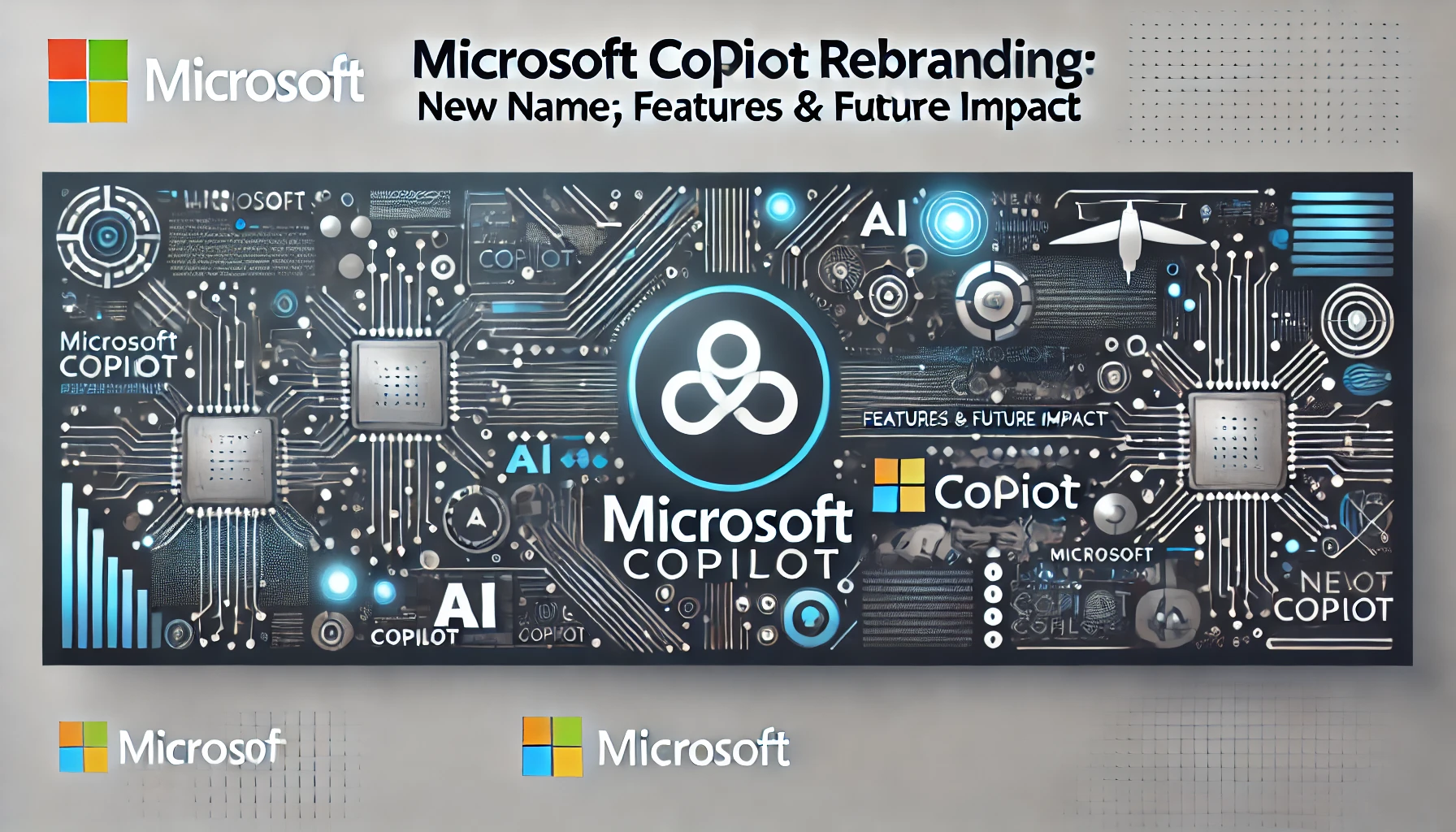Microsoft Rebranding of Copilot: New Name, AI Tools, and Strategic Shifts
Microsoft Rebranding of Copilot: Microsoft is no stranger to innovation and transformation, and the recent rebranding of its AI tool, Copilot, is a testament to its forward-thinking approach. As the tech giant continues to refine and expand its AI capabilities, the Microsoft Copilot rebranding has generated significant interest across the industry. This shift isn’t just about a new name—it signals broader changes in Microsoft’s AI strategy, the introduction of new features, and a reimagined identity for its AI tools. In this blog, we’ll explore everything you need to know about the Microsoft Copilot rebranding, including the potential new name, the latest updates for 2024, and the features that make Microsoft AI Copilot a standout tool in the market.
Why Microsoft is Rebranding Copilot: The Strategic Vision Behind the New Name
The decision to rebrand Microsoft Copilot is more than just a cosmetic change; it’s a strategic move that aligns with Microsoft’s broader goals in the AI landscape. As the company continues to expand its AI portfolio, rebranding Copilot underlines its commitment to innovation and its desire to create a unified, recognizable brand for its AI tools.
1. The Evolution of Microsoft AI Tools
Microsoft has been at the forefront of AI development, with Copilot being one of its flagship offerings. Initially designed as an AI assistant to enhance productivity within Microsoft Office applications, Copilot quickly became an essential tool for professionals across various industries. However, as the scope of AI technology expanded, so did the capabilities of Copilot. The rebranding reflects this evolution, positioning the tool as more than just an assistant but as a comprehensive AI solution.
2. Potential New Name for Microsoft Copilot
One of the most anticipated aspects of the Microsoft Copilot rebranding is the potential new name. While Microsoft has not officially confirmed the new branding, rumors suggest that the tool may be integrated into a broader suite of AI products under a unified brand name. This could mean that Copilot will become part of a more extensive platform, offering a range of AI-powered tools designed to enhance productivity, creativity, and collaboration.
3. The Broader Impact of AI Rebranding
Rebranding AI tools like Copilot isn’t just about a fresh logo or a catchy name; it’s about repositioning the product in the market. Microsoft’s AI rebranding strategy aims to make its AI tools more accessible and appealing to a broader audience, including businesses, educators, and individual users. By creating a cohesive brand identity, Microsoft can better communicate the value and capabilities of its AI tools, making them more competitive in a rapidly evolving market.
What’s New with Microsoft Copilot in 2024? Key Updates, Features, and Industry Impact
As we move into 2024, Microsoft Copilot has undergone several significant updates, further solidifying its position as a leader in AI-powered productivity tools. These changes not only enhance the tool’s functionality but also align it more closely with Microsoft’s long-term vision for AI.
1. Microsoft Copilot Changes 2024: What to Expect
One of the most notable Microsoft Copilot changes in 2024 is the integration of advanced natural language processing (NLP) capabilities. This update allows Copilot to understand and respond to more complex queries, making it an even more valuable tool for users who rely on it for tasks like content creation, data analysis, and project management. Additionally, Copilot’s ability to integrate with other Microsoft AI tools has been enhanced, allowing for smoother workflows and more seamless collaboration across platforms.
2. Microsoft Copilot Update: Enhancing User Experience
The latest Microsoft Copilot update focuses on improving the user experience by making the tool more intuitive and user-friendly. For instance, the updated interface now includes customizable dashboards, allowing users to tailor the tool to their specific needs. Furthermore, Copilot’s predictive analytics capabilities have been upgraded, providing users with more accurate insights and recommendations based on their data. These updates are designed to make Copilot not just a tool but an integral part of the user’s daily workflow.
3. Microsoft AI Copilot News: Industry Reactions and Insights
The industry has been abuzz with news about Microsoft AI Copilot and its recent updates. Tech analysts and industry experts have praised Microsoft’s approach to AI, noting that the company’s focus on enhancing Copilot’s capabilities while rebranding it for broader appeal is a smart move. The rebranding and updates have positioned Microsoft as a leader in the AI space, particularly in the realm of productivity tools. As more businesses adopt AI technologies, tools like Copilot are expected to become increasingly indispensable, further cementing Microsoft’s dominance in this area.
Exploring the Features and Capabilities of Microsoft AI Copilot: What You Need to Know
Microsoft AI Copilot has come a long way since its inception, and its current features and capabilities make it one of the most powerful AI tools available today. In this section, we’ll explore the key features that set Microsoft AI Copilot apart from its competitors.
1. Microsoft AI Copilot: A Versatile Tool for Professionals
At its core, Microsoft AI Copilot is designed to enhance productivity by automating routine tasks and providing intelligent insights. One of its standout features is its ability to generate content based on user input, making it an invaluable tool for writers, marketers, and content creators. Copilot can draft emails, create presentations, and even generate reports, all with minimal input from the user. This level of automation not only saves time but also ensures that the output is of high quality.
2. Microsoft Copilot Features: Integration and Customization
Another key feature of Microsoft AI Copilot is its integration with other Microsoft tools, such as Office 365, Teams, and Azure. This seamless integration allows users to move effortlessly between applications, leveraging Copilot’s capabilities across different platforms. Additionally, Copilot’s customization options enable users to tailor the tool to their specific needs. Whether it’s setting up automated workflows or creating personalized dashboards, Copilot offers a level of flexibility that makes it suitable for a wide range of applications.
3. The Future of Microsoft AI Copilot: What Lies Ahead
Looking ahead, Microsoft AI Copilot is expected to continue evolving, with new features and capabilities being added regularly. As AI technology advances, we can anticipate even more sophisticated tools being integrated into Copilot, further enhancing its utility. For example, future updates may include more advanced machine learning algorithms, allowing Copilot to learn from user behavior and make even more accurate predictions and recommendations.
The Broader Implications of Microsoft’s AI Rebranding: What It Means for the Industry
The Microsoft Copilot rebranding is part of a broader trend in the tech industry, where companies are increasingly focusing on creating unified, cohesive brand identities for their AI tools. This shift has significant implications for the industry as a whole.
1. Rebranding AI Tools: A Growing Trend
Microsoft’s decision to rebrand Copilot is indicative of a larger trend in the tech industry. As AI tools become more prevalent, companies are recognizing the importance of branding in differentiating their products from the competition. By creating a strong, recognizable brand, companies can build trust with their users and establish themselves as leaders in the AI space.
2. The Impact on Users and Businesses
For users and businesses, the rebranding of AI tools like Copilot offers several benefits. A unified brand identity makes it easier for users to understand the capabilities of the tool and how it can be integrated into their workflows. Additionally, rebranding can lead to improved customer support and better user experiences, as companies invest more resources into developing and promoting their AI products.
3. The Future of AI Branding
As the AI market continues to grow, branding will play an increasingly important role in shaping the industry’s future. Companies that can successfully create strong, cohesive brands for their AI tools will have a significant advantage in attracting and retaining customers. For Microsoft, the Copilot rebranding is just the beginning of what is likely to be a long-term strategy focused on establishing itself as the leader in AI technology.
Conclusion
The Microsoft Copilot rebranding marks a significant shift in the company’s approach to AI technology. By rebranding Copilot and introducing new features and capabilities, Microsoft is positioning itself at the forefront of the AI industry. As we look to the future, it’s clear that Microsoft AI Copilot will continue to play a crucial role in enhancing productivity and transforming the way we work. Whether you’re a business leader, a content creator, or simply someone interested in the latest tech trends, the rebranding and updates to Copilot are worth paying attention to.
For more in-depth analysis and insights into the latest in AI and technology, be sure to visit Regent Studies, where you can find a wealth of resources and information on cutting-edge developments in the tech world. Stay informed and ahead of the curve with the latest news and updates on Microsoft AI Copilot and more.




